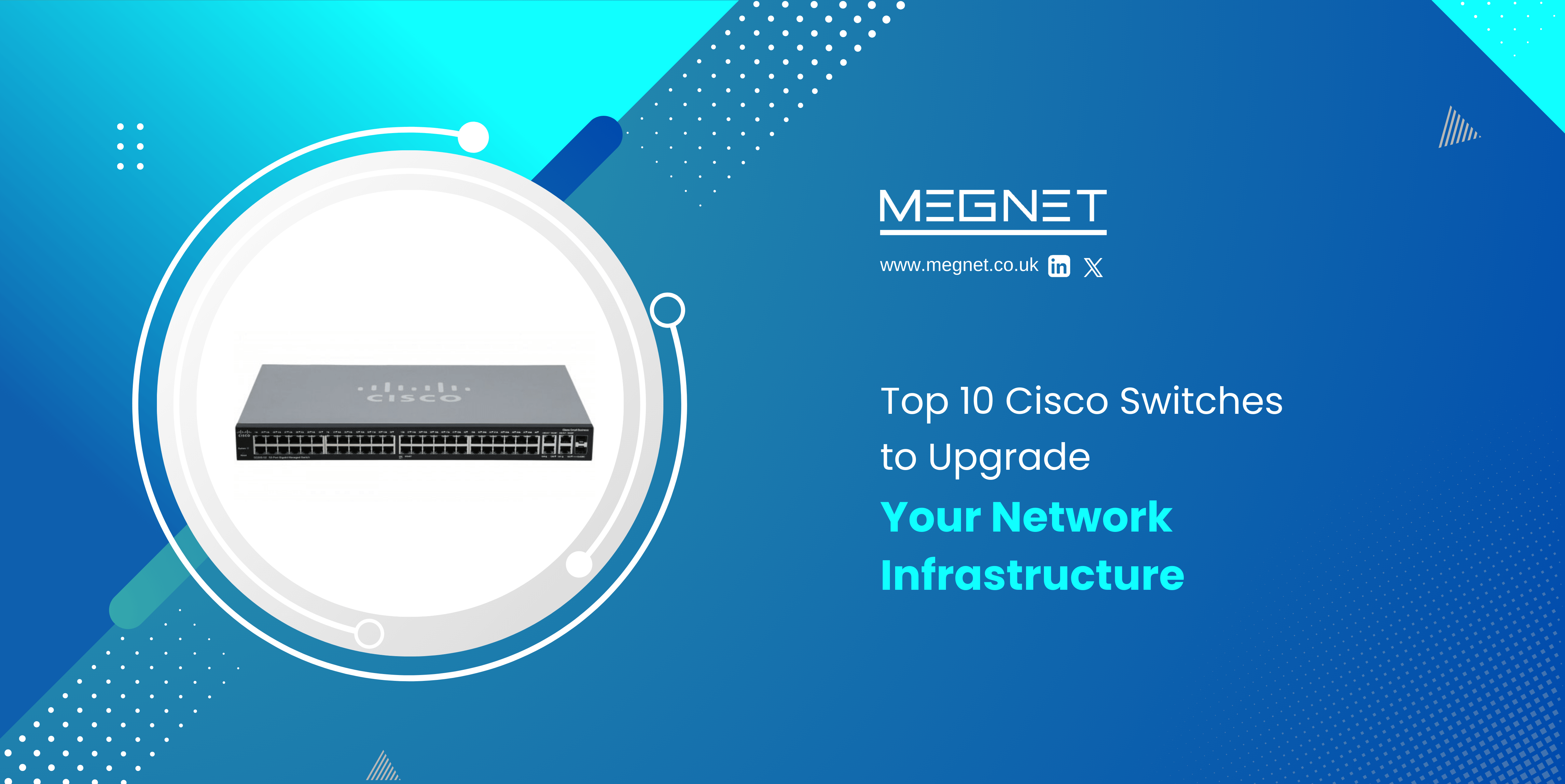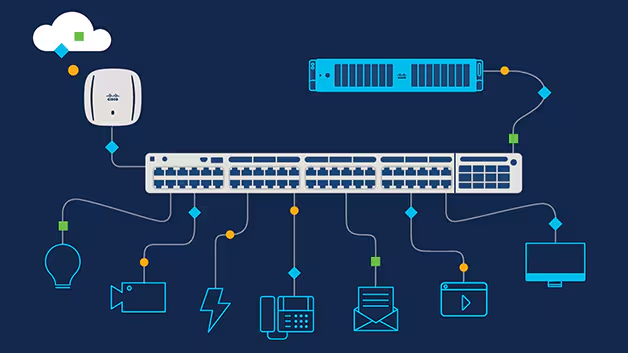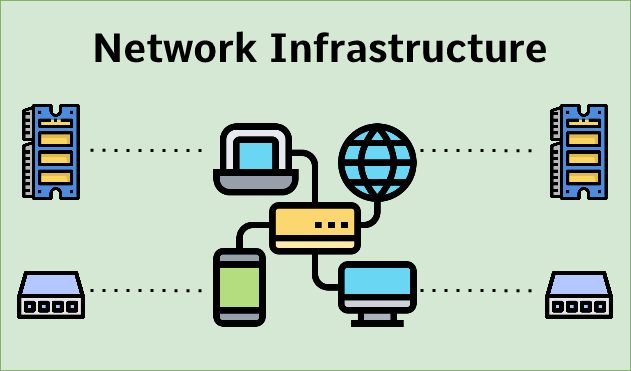
Top 10 Cisco Switches to Upgrade Your Network Infrastructure
In today’s rapidly evolving digital landscape, a robust and reliable network infrastructure is crucial for businesses of all sizes. Cisco, a pioneer in networking solutions, offers a diverse range of switches designed to meet the varying needs of modern enterprises. Whether you’re looking to enhance performance, scalability, or security, Cisco switches are renowned for their quality and innovation. In this comprehensive guide, we’ll explore the top 10 Cisco switches that can elevate your network infrastructure to the next level.
Cisco Systems has long been synonymous with cutting-edge networking technology. From small businesses to large enterprises, Cisco switches are trusted worldwide for their reliability, performance, and advanced features. As businesses continue to expand their digital footprint, the demand for high-speed, secure, and scalable networks has never been greater. Cisco switches play a pivotal role in enabling organizations to achieve seamless connectivity, improved efficiency, and enhanced security across their network environments.

Understanding Cisco Catalyst Switches
Before delving into the different models of Cisco Catalyst switches, it is essential to understand their core features and functionalities. All Cisco Catalyst switches use a modular design, allowing businesses to add or remove modules according to their networking needs. This makes it easier for companies to scale their infrastructure as they grow.
Additionally, Cisco Catalyst switches are known for their high performance and reliability. They offer advanced security features and easy management options, making them a popular choice among enterprises of all sizes.
Choosing the Right Model
When it comes to choosing the right Cisco Catalyst switch, the first step is to understand your organization’s networking requirements. Here are some key factors to consider:
- Network Size: The size of your network will determine the number of ports and interfaces required on your switch. Cisco offers a variety of switches under their 3000 series, with different port densities for small, medium, and large networks.
- Performance: If your business requires high-speed data transfer, then it is essential to choose a switch with Gigabit Ethernet capabilities. The Cisco Catalyst 9400 series offers up to 32 ports of 10-Gigabit Ethernet and four ports of 40-Gigabit Ethernet.
- Security Features: With the increasing number of cyber threats, security has become a top priority for businesses. The Cisco Catalyst 9000 switching platforms offer advanced security features like TrustSec and MACsec encryption to ensure the safety of your network.
- Futureproofing: As your organisation grows, so will your networking needs. It is crucial to choose a switch that can support future upgrades and expansions. The Cisco Catalyst switches are designed with scalability in mind, making them a reliable long-term investment.

Criteria for Selecting Cisco Switches
When choosing the right Cisco switch for your organization, several factors come into play:
- Performance: Consider the switching capacity, throughput, and latency to ensure smooth data transmission.
- Scalability: Evaluate the switch’s ability to scale as your business grows, supporting additional users and devices.
- Features: Look for advanced features such as VLAN support, QoS capabilities, Layer 3 routing, and security protocols.
- Budget: Determine the cost-effectiveness of the switch relative to its features and benefits.
Explore our top 10 picks and embark on a journey towards a more resilient and agile network environment with Cisco’s industry-leading technology.
Now, let’s delve into our curated list of the top 10 Cisco switches:
- Cisco Catalyst 9300 Series
Model: Catalyst 9300
Key Features: High-density stacking, advanced security, Cisco DNA support
Benefits: Ideal for enterprise deployments, enhances network visibility and control
- Cisco Catalyst 9400 Series
Model: Catalyst 9400
Key Features: Modular design, high performance, Cisco Stack Wise Virtual
Benefits: Scalable core and distribution layer switching, supports diverse deployment scenarios
- Cisco Catalyst 9500 Series
Model: Catalyst 9500
Key Features: Intent-based networking, advanced analytics, 100G connectivity options
Benefits: Enables digital transformation, improves network agility and intelligence
- Cisco Catalyst 9600 Series
Model: Catalyst 9600
Key Features: Multigigabit Ethernet, advanced security, high availability
Benefits: Designed for high-density campus deployments, supports IoT and mobility
- Cisco Catalyst 3650 Series
Model: Catalyst 3650
Key Features: Converged wired and wireless, Flexible NetFlow, Energy Efficient Ethernet
Benefits: Simplifies network operations, enhances user experience with integrated wireless support
- Cisco Catalyst 3850 Series
Model: Catalyst 3850
Key Features: Stackable, Cisco StackWise-480, Power over Ethernet (PoE+)
Benefits: Optimizes network performance, supports seamless application experience
- Cisco Nexus 9000 Series
Model: Nexus 9000
Key Features: Data centre switching, VXLAN support, Cisco Application Centric Infrastructure (ACI)
Benefits: Delivers scalability and automation for modern data centres, enhances workload mobility
- Cisco Meraki MS Switches
Model: Meraki MS
Key Features: Cloud-managed, intuitive dashboard, integrated security features
Benefits: Simplifies network management, ideal for distributed environments
- Cisco Small Business SG350 Series
Model: SG350
Key Features: Gigabit performance, IPv6 support, energy-saving technology
Benefits: Affordable solution for small to medium-sized businesses.
- Cisco Industrial Ethernet 4000 Series
Model: Industrial Ethernet 4000
Key Features: Industrial IoT support, ruggedized design, enhanced security
Benefits: Enables connectivity in harsh environments, supports critical industrial applications

Long-term Benefits of Choosing Cisco Switches
- Reliability: Cisco switches are known for their robustness and uptime, minimizing network downtime and ensuring continuous operations.
- Scalability: As your business grows, Cisco switches offer scalability options that allow you to expand your network seamlessly without compromising performance.
- Security: With built-in security features and advanced threat detection capabilities, Cisco switches help protect your data and network infrastructure from cyber threats.
- Performance: High-speed connectivity, advanced traffic management, and optimized data transmission contribute to improved network performance and user experience.
- Management and Support: Cisco’s comprehensive management tools and support services simplify network administration and troubleshooting, reducing operational complexity.
Conclusion
Upgrading your network infrastructure with Cisco products is a strategic investment in improving operational efficiency, enhancing security posture, and enabling future growth. Whether you operate a small business or manage a large enterprise, Cisco’s diverse portfolio ensures there’s a switch to meet your unique networking challenges.
By choosing Cisco switches, you’re not just investing in hardware; you’re investing in the reliability and innovation that Cisco has built its reputation on. Elevate your network infrastructure today with Cisco switches and stay ahead in the digital age.
Upgrading your network infrastructure with Cisco switches represents more than just a hardware investment—it’s a strategic decision to future-proof your organization’s connectivity and security. Cisco’s commitment to innovation and reliability ensures that each switch not only meets current demands but also anticipates future requirements as technology evolves.
FAQ's
Layer 2 switches operate at the Data Link layer (Layer 2) of the OSI model and make forwarding decisions based on MAC addresses. Layer 3 switches operate at the Network layer (Layer 3) and can perform routing functions based on IP addresses.
VLANs are logical groupings of devices within a network, isolated from other VLANs. Cisco switches support VLANs by allowing administrators to create multiple virtual LANs on a single physical switch, enhancing network segmentation and security.
PoE enables devices like IP phones, cameras, and wireless access points to receive power and data over Ethernet cables. Cisco switches, such as the Catalyst 9300 and 9400 Series, support PoE and PoE+ (802.3at), simplifying deployment and reducing infrastructure costs.
QoS mechanisms prioritize certain types of traffic (e.g., voice or video) to ensure consistent performance and minimize latency. Cisco switches implement QoS through features like classification, marking, and queuing to optimize network performance.
Stacking allows multiple physical switches to operate as a single logical unit, simplifying management and enhancing scalability. Cisco switches, such as the Catalyst 9300 and 9400 Series, support stacking to increase port density and resilience.
SD-Access automates network provisioning and policy enforcement through centralized management. Cisco switches integrate with SD-Access to streamline operations, enforce consistent policies, and improve network security.
Cisco Nexus switches offer high performance, scalability, and reliability tailored for data centre environments. Features like VXLAN support for virtualized networks and Cisco ACI integration provide agility and operational efficiency.
Cisco Meraki MS switches are cloud-managed, offering simplified deployment, centralized management, and intuitive dashboards for network monitoring and troubleshooting. They are ideal for distributed environments and remote management.
Cisco switches include features like MACsec encryption, ACLs (Access Control Lists), IP Source Guard, and Dynamic ARP Inspection to mitigate security risks and safeguard network integrity against unauthorized access and attacks.
Cisco switches support IoT deployments by providing PoE/PoE+ capabilities for powering IoT devices, secure connectivity through VLANs and segmentation, and enhanced management features to handle large-scale deployments.








Leave a comment
Your email address will not be published. Required fields are marked *